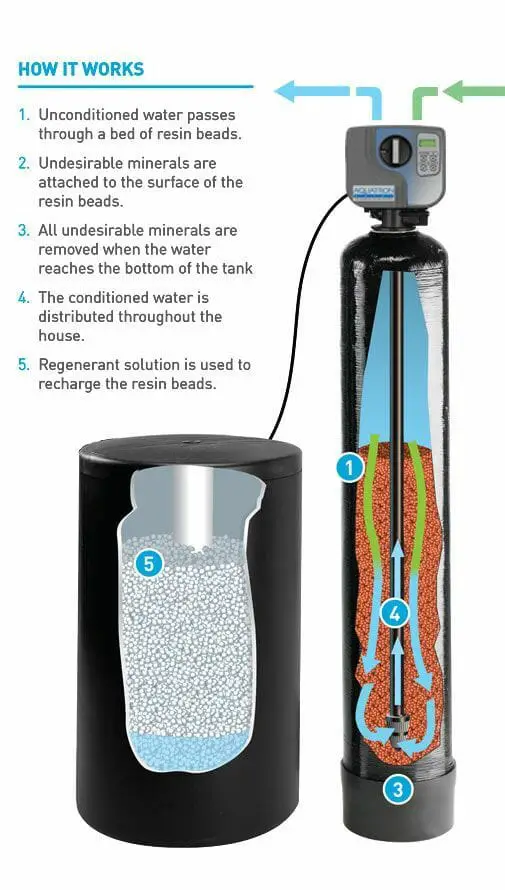Table of Content
Calcium and magnesium are healthy minerals we need to survive. Calcium is essential for bone health and magnesium supports heart and nerve function. Water softeners are usually installed on the main water line and require a connection to an electrical outlet for power.

In the freshly regenerated mineral tank, the beads are now coated with sodium or potassium provided by the brine tank. This small amount of salt displaced from the beads becomes suspended in the water and moves on into the home water supply. This small amount of salt in the water is generally not a problem, except for people who have strict limitations on sodium. Involves an ion exchange process, which removes both magnesium (Mg2+) and calcium (Ca2+) from water. Over time the resin beads in the water softener become saturated with hard minerals and will need to be cleaned with a regeneration process to keep softening water. A strong brine solution from the brine tank is needed to rinse out the accumulated harsh minerals from the resin beads.
The Control Valve
Ava has over 10 years of experience in the water filtration industry and has worked with some of the top companies in the field. Hard water minerals are abrasive and can etch fine glassware. And as dishes dry in the dishwasher, excess calcium leaves behind tough-to-clean white spots. Water softening also helps reduce soap scum and improve the taste, smell, and feel of the water.
The magnets on each unit should be shipped and stored separately, and it’s essential to keep them pulled apart throughout the process. Overall, a descaler ought to increase the life of your pipes and appliances. Your water quality matters, but the journey to improving your water quality begins with understanding what measures can help. Are you curious about the effects of hard water in your home? It’s an interesting phenomenon that has far-reaching effects.
How do water softeners work?
Manual regeneration requires you to physically start the regeneration of the water softener. The mineral tank is the tall narrow tank where the actual water softening occurs. It is filled with several cubic feet of porous plastic polystyrene resin beads. As water flows through this tank, the negatively charged beads attract and hold the positively charged calcium and magnesium particles in the water.

Water softeners are a low maintenance solution to treating hard water. We want to provide you with a few tips to ensure you get the most out of your water softener, and to make it last as long as possible. The minerals that the water softener removes can cause a crusty buildup. You may have had this issue prior to your water softener being installed. A water softener of some kind is the obvious solution to both of these problems, and a magnetic water softener might be the best option overall. The process of magnetic softening intends to reduce the hardness of your water before it even enters your home water system.
You’re signed up
A water softener safeguards your home and increases its resale value. The resin beads must be regenerated periodically with a sodium-based solution to maintain their effectiveness. A fast flow cycle follows to compact the resin bed and wash off the last of the brine and minerals. If you do not manually add the salt and the capacity of the beads to soften is low, the water that comes out of the tank will still be hard. Most newer, high-efficiency water softeners use less than 10 bags of salt per year.

So getting used to a magnetic water softener may take some time. Magnetic water softeners are also famous for needing practically no maintenance after installation. For this reason, they are typically less expensive than other water softeners on the market, including the more popular salt-based softeners. However, overall sodium levels are minimal, even with exceptionally hard water. Although the FDA considers softened water to be very low in sodium, you should be cautious if you have conditions such as hypertension. The amount of sodium in softened water is determined by how hard your water is.
What Is Magnetic Water Softener?
You need to program the maximum capacity of the water softener so that the control valve works automatically. The pre-programmed max capacity of the water softener is dependent on factors such as the number of occupants in your home, hardness of the water, and water usage per day. By so doing, your water will lather faster with soap, and your appliances will have a longer lifespan. The water will also clean you better without drying your hair or your skin. And if you drink water from the tap, magnetic water treatment should not change how your water tastes. While it might taste a little different than a salt-based softener, it should not alter the overall taste of the water that you consume daily.
There is no scientific evidence that magnetic water softeners properly aid in water treatment3,4. When the beads hold the calcium and magnesium ions, they release sodium ions. The resulting water is free of calcium and magnesium, and it flows to your home. However, the water that flows to your home has sodium ions, which do not cause hardness. Because opposite charges attract, the negative charge of the resin beads attracts the positive charge of the calcium and magnesium minerals.
The counter-current regeneration process sends water up through the bottom of the regeneration tank, where water usually leaves the tank. Most water softeners can remove 3 PPM of iron or less, but some have a specialized resin that allows for slightly better iron removal. Most softeners come pre-set to regenerate every three days until you program the head. Once you input your water hardness level, the system takes it from there. If you have the repair shop on speed dial, hard water may be to blame.
As the water passes through the pipe, the magnets attract the minerals. The strength of the magnetic field varies based on your household water usage and the hardness of your water. Once attracted, the system makes the minerals insoluble in water, and the resulting water flows into your pipes. The brine tank produces salt, which is carried into the mineral tank to top up the resin bed.
This eliminates the need for a manual regeneration of your water softener. Instead of calculating how often your water softener should regenerate, you can set it and forget, enjoying predictably soft water on a daily basis. Small, but notable health risk for people on low-sodium diets. The ion exchange process adds roughly 7.5 mg per quart of water. The water softener industry spends millions of dollars to convince consumers that water softeners are absolutely necessary for every home.

No comments:
Post a Comment